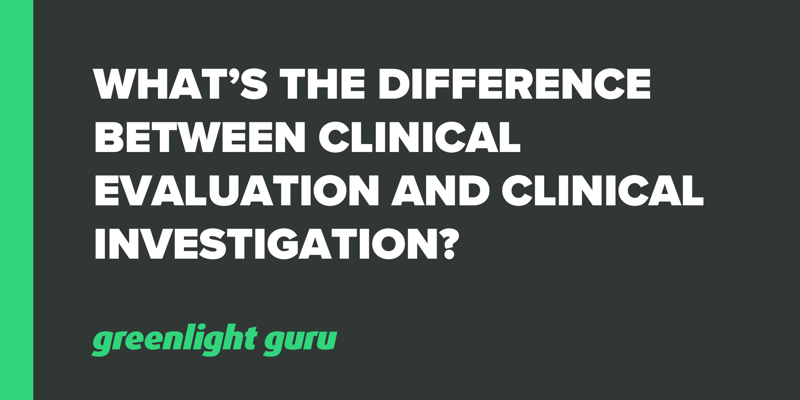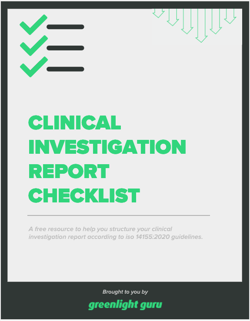Clinical Evaluation vs. Investigation: Everything You Need to Know

Within the myriad of regulations and standards governing medical devices, there are a number of similar terms that tend to be used interchangeably within the industry, even though regulatory bodies ascribe them precise, distinctly different meanings.
“Clinical evaluation” and “clinical investigation” are two such terms that are entirely distinct but are often confused with one another, even among medical device professionals. The reason is apparent enough—the words “evaluation” and “investigation” have similar meanings that are often used interchangeably outside of the medical device industry.
This article will clear up the confusion by explaining the difference between clinical evaluation and clinical investigation when used in the context of medical devices in order to help you understand what each process requires from you as the manufacturer for obtaining a CE marking.
What is a clinical evaluation?
In order to sell a medical device in the EU market, the manufacturer must first obtain a CE marking for the device, which provides legal proof that the product has met high safety, health, and environmental standards.
The EU Medical Device Regulation (EU MDR) requires medical device manufacturers to perform a clinical evaluation of their device, as part of that CE marking process, which it defines as,
A systematic and planned process to continuously generate, collect, analyse and assess the clinical data pertaining to a device in order to verify the safety and performance, including clinical benefits, of the device when used as intended by the manufacturer.
MDR requires medical device manufacturers to submit a Clinical Evaluation Report (CER) to provide evidence that they have performed a clinical evaluation and that it has proven the safety and efficacy of the device.
To help medical device companies comply with these specific requirements of the regulation, the European Commission (EC) has released a guidance document on clinical evaluation—the most recent version of which is known as MEDDEV 2.7.1.
How does a clinical investigation compare to a clinical evaluation?
Clinical investigation refers to a systematic clinical trial of a medical device that uses human participants to assess the safety and/or efficacy of the device.
One way to differentiate between clinical evaluation and clinical investigation is to remember that a clinical evaluation is always necessary. It can lead to a clinical investigation if additional clinical data is needed to prove a device is safe and effective, but a clinical investigation is not a surepart of the process.
For most low- to medium-risk devices, a clinical investigation will not be necessary, as there is likely ample clinical data already available for collection and analysis to prove device safety and efficacy. If there are gaps in the clinical data that cannot be resolved, however, then MEDDEV 2.7.1 recommends that medical device companies perform clinical investigations.
According to MEDDEV 2.7.1, indications that your device may require clinical investigation include:
-
New design features and/or new materials
-
A new intended purpose
-
Making new claims about the device
-
New types of users
-
Serious direct and/or indirect risks
-
Invasiveness or contact with mucosal membranes
-
Increased duration of use or number of reapplications
-
Incorporation of medicinal substances
-
Use of animal tissues other than in contact with the skin
-
New recognized risks or the availability of alternatives with lower risks or higher benefits
How to write a clinical evaluation report according to MEDDEV 2.7.1
MEDDEV 2.7.1 offers a five-stage procedure for performing the clinical evaluation of a medical device, culminating in the production of a CER:
- Stage 0 - Scoping: This initial stage will determine the context of the clinical evaluation, including a detailed look at the device being evaluated in order to understand and define how the device works, the underlying technology behind it, and any claims being made about the device’s safety or performance.
- Stage 1 - Identification of pertinent data: In this stage, evaluators will outline the premarket and post-market clinical data they will be using to conduct the clinical evaluation.
- Stage 2 - Appraisal of data: In Stage 2, the pertinent data that has been collected is assessed for its relevance to the clinical evaluation and its validity. Each data set is also weighted by its overall contribution to the clinical evaluation of the device.
- Stage 3 - Analysis of the clinical data: This stage covers the analysis of the collected data. Evaluators will draw conclusions regarding the device’s compliance with safety and performance requirements as well as identify any residual risks, uncertainties, or unanswered questions.
- Stage 4 - Production of clinical evaluation report: The final stage is the production of the CER, which describes all previous stages and conclusions reached by the evaluators. There is no standard length or amount of information that must be included in the CER, as it depends on the device and the evaluation.
Remember, the MDR describes clinical evaluation as a plan to “continuously generate, collect, analyze and assess the clinical data pertaining to a device.” The submission of your initial CER is just the first step in this process.
After a device obtains a CE marking and is placed on the market, clinical evaluation must be regularly performed with updated reports through the monitoring of new clinical data and post-market surveillance.
Streamline your clinical evaluation & investigation processes with closed-loop quality system traceability
The clinical evaluation requirements for continuous collection and analysis of data require something of their own—an eQMS that is built to support the unique needs of medical device manufacturers.
Greenlight Guru’s QMS software uses AI and machine learning technologies to provide teams with closed-loop traceability of all quality system data and instantly visualize the downstream effects of any changes in your documentation. Get your free demo today!
Looking for a design control solution to help you bring safer medical devices to market faster with less risk? Click here to take a quick tour of Greenlight Guru's Medical Device QMS software
Laura Court is a Medical Device Guru and Mechanical Engineer who loves learning about new technology and sharing her experiences with others. She has experience in New Product Development and Manufacturing with both small and large companies. Having managed products through their full product lifecycle into post...
Related Posts
MDCG 2020-6 Explained: Sufficient Clinical Evidence for Legacy Medical Devices in the EU
The Clinical Evaluation Literature Review Process: Identifying and Appraising Clinical Data (Part 2 of 4)
MHRA Guidance Document on Clinical Investigations in UK
Get your free checklist
Clinical Investigation Report Checklist


%20The%20Ultimate%20Guide%20to%20Clinical%20Evaluation%20of%20a%20Medical%20Device-1.png?width=180&name=(cover)%20The%20Ultimate%20Guide%20to%20Clinical%20Evaluation%20of%20a%20Medical%20Device-1.png)








